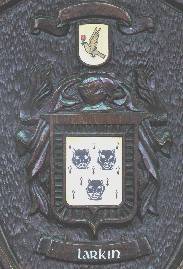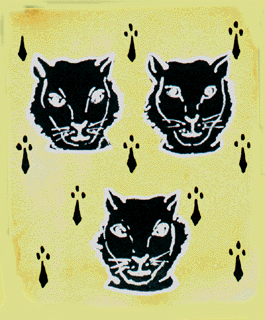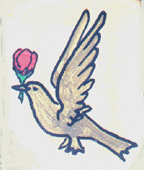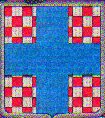![]()
![]()
|
History
of Larkin Name Part One |
 The
blue cross symbolizes one granted to a Knight of the Crusades. The
blue cross symbolizes one granted to a Knight of the Crusades.
The checkerboard background is called "Chequy". The O Lorcain Heraldic Shield This is the only O Lorcain shield of Irish origin. We have a Larkin Shield in our home (British origin) with three leopard's faces on a field of ermine. We understand this shield sometimes has a walking lion. As was the procedure of "that time", and for generations to come, it would go to first-born, direct descendant of the individual Knight who originally earned it. |
![]()
 |

I looked for a "englarcrest.jpg," in the same location, but it wasn't
there. Wanted to see if it opened in MSIE linkingr..
![]()
 |
IRISH
|
 |

|
ENGLISH
|

|
Long before there were were surnames,
people were called by descriptive names.
These names described one or more of the following:
where they lived
their occupation
what they looked like
how they behaved
Ancient Ireland was populated by the
Celts,
a warrior race organized into family clans,
and known for their lack
of fear in battle.
In the gaelic
language they spoke,
the word lorc meant "fierce".
Some pre-Norman
Celtic warrior must have
so impressed his peers with his ferocity in combat
that they started calling him
"The Fierce One".
When the name stuck,
his
immediate progeny
would
have been called sons
or grandsons
of Lorc.
Later, a family clan named Olorcan
would have arisen,
made up of people descended from the original warrior.
Finally,
sometime in the 14th century,
O'Larkin
would have become a conventional surname.
The CELT Project, at University College,
Cork, Ireland
has a searchable online archive of early gaelic texts.
A number of them contain long genealogical lists that take the form:
Duncan, son of Donald,
son of Lorcan,
son of Connor...
and so on, and on.
729. Úgaine Mór & Badbchad dá m. Echach Buadaig m. Ladcrai m. Fiachach Tolgraich. Úgaine Már dá m. ar fichit leis & ní fárgaib nech díb clainn acht duo tantum .i. Láegaire Lorc senathair Laigen & Cobthach Cáel Breg senathair Óengusa Tuirmich Temra.
1004. Máel Domnaich m. Anbítha m. Dub Thíre m. Cuangusa m. Dotchada m. Guasachtaich m. Máel Ruain m. Dadaill m. Sinill m. Lorcáin m. Dalláin m. Trechuirne m. Tréin m. Sige m. Andiled m. Beccáin m. Delbaíth m. Tháil m. Conaill Echluaith m. Lugdach Mind. [The "m." stands for mac or "son of".]
As one might expect for a time when most people
could not write or spell their own names,
there are many variations of the same generic name.
Lorc![]() Lorcc
Lorcc ![]() Luircc
Luircc ![]() Lorccain
Lorccain![]() Lorcain
Lorcain
Lorccan ![]() Lorcan
Lorcan![]() Olorcan
Olorcan
post-gaelic
O'Larkin ![]() Larkin
Larkin ![]() Larkins
Larkins
The Olorcan or O Lorcain
clan was prominent in
County Wexford in the south of Ireland
Also found in the Counties Tyrone
Armagh in the north.
Cromwell drove those who refused to
declare allegiance
to the British
Crown and the Protestant Church
into Connaught, the unsettled western part of Ireland.
So the Larkin surname came to be clustered in the western county of Galway as well.
![]()
The Ancient History of the Distinguished Surname

Larkin
The Irish culture has made a large impact on world history,
a contribution which is totally disproportionate to the population of that beautiful
but tiny Emerald Isle. This culture has produced many world leaders, statesmen,
artists, clerics and scholars.
The history of the name Larkin is woven into the fabric of Irish history. Researchers have isolated historical data on the name Larkin using books by O'Hart McLysaght and O'Brien, the Four Masters and Woulfe, church baptismals, parish records, and ancient land grants.
Historical research found that the family name Larkin was first found in county Galway where they had been seated from ancient times.
Your name Larkin occurred in many references, from time to time the surname was recorded as Larkin, O'Larkin, and these changes in spelling even occurred between father and son. Unfortunately, church officials and scribes spelt the name as it sounded, and it was not uncommon to add a name spelt several different ways during the lifetime of the same person, when he or she was baptized, another when that person was married, and yet another appeared on the gravestone.
The legendary Kings of Ireland some 1500 years B. C., were descended from King Milesius of Spain, the grandson of Breoghan (Brian), King of Galicia, Andalusia, Murcia, Castile and Portugal. King Milesius turned his attention northward to Ireland to fulfill an ancient Druidic prophecy. He sent an army to explore this fertile island. On finding that his son had been murdered by the three resident Irish Kings (the Danans), Milesius gathered another army to take his revenge on the Irish. He died before he embarked on the trip. His remaining eight sons conquered Ireland.
Heremon, eldest son of Milesius, reigned in Ireland for fourteen years, along with his brothers Heber, Jr., and Ithe. They named the land Scota or Scotia, their mother's name, the land of the Scots. This name would later be taken by the Irish King Colla in 357 A.D., when he was exiled to the Scottish western Isles, leaving the name 'Ir-land ', land of Ir, the youngest of the four sons of Milesius, to the Emerald Isle. The four Irish kingdoms eventually broke into five separate nations under the High King, or Ard Righ. These royal lines would later produce such great Kings as the 2nd century King Conn of the hundred battles, the 4th century King Niall of the Nine Hostages who died in France while cutting off 'the retreat of the Romans from Britain, and King Brian Boru who died in the Battle of Clontarf 1014, finally expelling the Vikings from Dublin and Ireland.
This great Gaelic family of Larkin emerged in later years in county of Galway. The O'Lorcans of Leinster were descended from the Kings of Leinster and were dispossessed of their territories in county Leinster by the Anglo Norman invaders under Strongbow in 1172. They moved to the west to Galway and to the north to Ulster where they became the Chief of Farney. They later established a branch in Tipperary. They moved into England into Herefordshire, Cambridgeshire and Kent. Notable amongst the .1~41nily at this time was Larkin of Galway.
In 1172 A.D. Dermott McMurrough, King of Leinster, in his struggle for the position of Ard Righ, King of all Ireland, had requested King Henry II of England for assistance. Many proud native Irish families lost their chiefships, territories and possessions following the 1172 invasion and the spoils were divided amongst the Norman knights and nobles. This was followed by Cromwell's invasion in 1640, when, further loss of land befell the unfortunate Irish people. Later, Ulster in the north was seeded with Protestant Scottish and English. Again, many Irish families abandoned their ancient territories and many moved south. Each successive invasion had brought new family lines, new names to add to the native Gaelic race.
In 1845, the great potato famine caused widespread misery and poverty, and the exodus from Ireland began. Within fifty years the population was reduced to less than half. Many Irish joined the armada of sailing ships which sailed from Belfast, Dublin, Cork, Holyhead, Liverpool, and Glasgow, bound for the New World or to Australia. Some called these ships the White Sails, designed originally to hold 100 persons but which frequently sailed with 400 and 500 people on board. Others, more realistically, called these vessels the "Coffin Ships," when 30% to 46% of the passengers died of cholera, smallpox and the elements.
In North America some of the first migrants which could be considered kinsmen of the sept Larkin and of that same family included Elizabeth Larkin settled in Virginia in 1637; William Larkin settled in Boston in 1630; Denis, Edward, James, John, Michael, Patrick, Richard, Thomas and William Larkin, all arrived in Philadelphia between 1840 and 1860; Francis, James, John, Mathew, Michael, and Patrick Larkins, all arrived in Philadelphia between 1840 and 1860.
In the 'Colonies " the Irish played an important role in building nations, the railroads, coal mines, bridges and canals. They lent their culture to the arts, sciences, commerce, religion and the professions. Typically, during the unsettled times of the 19th century, 9 rebellious Irishmen were sentenced to death. Their sentence was commuted to banishment to the "colonies In 1888, a surprised Queen Victoria learnt that all nine had become prominent statesmen, prime ministers, high court judges, generals, Mayors or bishops.
The Irish moved westward with the wagon trains, and settled the mid west, some trekking as far as the West Coast. During the American War for Independence some were loyal to the cause joining the Irish Brigades. Others were loyal to the Crown, and moved north into Canada, becoming known as the United Empire Loyalists and being granted lands on the banks of the St. Lawrence and the Niagara Peninsula.
Meanwhile, the family name Larkin produced many prominent people William Larkin, American Engineer; Arthur Larkin, American Business executive; Frederick Larkin, American Banker; Phillip Larkin, British Novelist.

![]()
Copyright © Southern
Scripts 2010 |